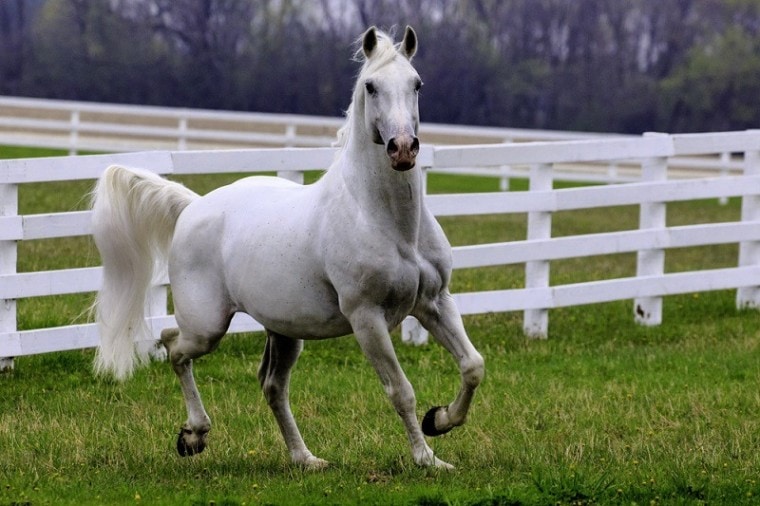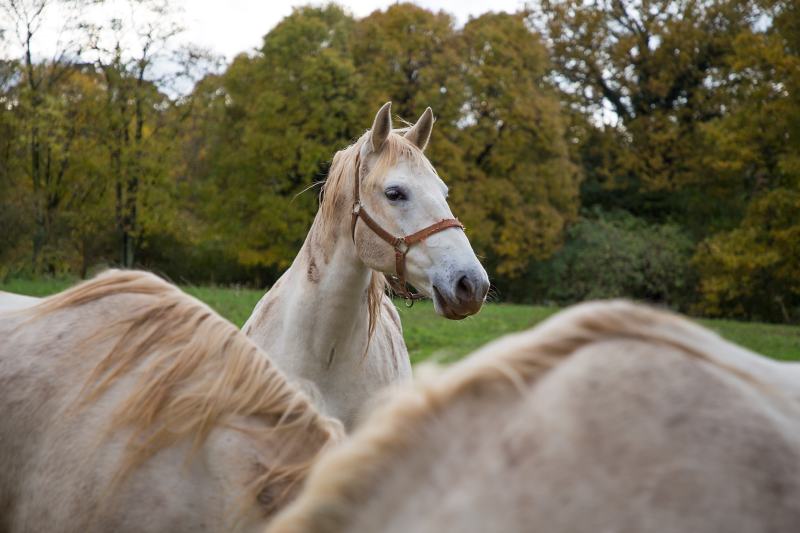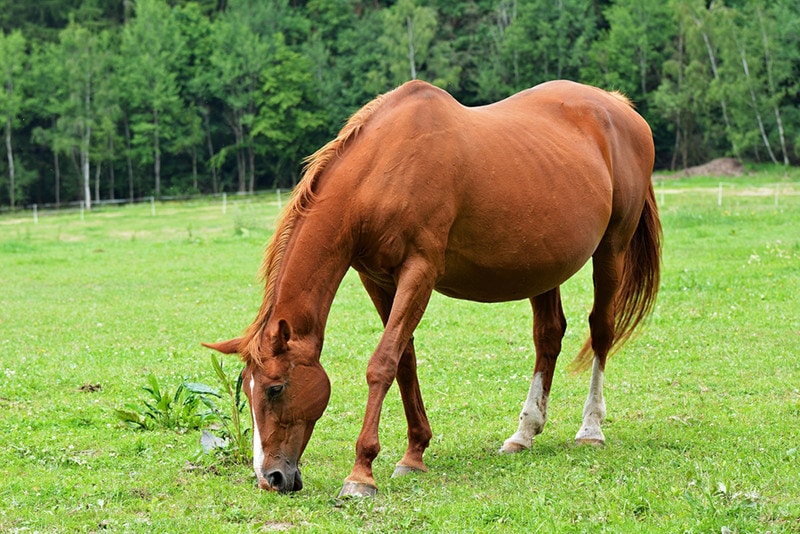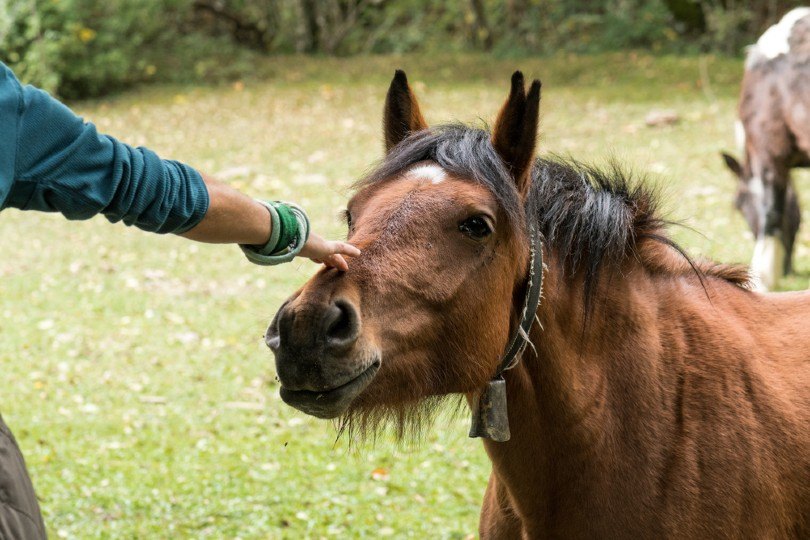
Click to Skip Ahead
If you aren’t familiar with the Lipizzaner horse, it is a rare breed with a long and fascinating history. Known for being a dressage and classical riding pro, the Lipizzaner is a staple of the Spanish Riding School in Austria. Though this horse breed has been endangered many times throughout history, there are now about 11,000 Lipizzaners in the world today, and the number of these horses will hopefully continue to rise.
Want to learn more about the beautiful and unique Lipizzaner? Keep reading!
| Care Level: | Moderate |
| Temperature: | Most climates |
| Temperament: | Intelligent, easily trained, stubborn |
| Colors: | Mostly gray, occasionally solid black or bay |
| Lifespan: | 30–35 years |
| Weight: | 1,300 lbs (stallion), 1,000 lbs (mare) |
| Height: | 15–16.1 hands (stallion), 14.2–15.2 hands (mare) |
The Lipizzaner has been around for centuries and is rather well-known. However, there have been a few points in their long history where the breed almost went extinct. One of the more famous times it seemed as if the Lipizzaner was bound to be lost was during World War II. The famed Spanish Riding School, where the majority of the breed was located, was situated in an area extremely close to enemy territory. The school was concerned about how safe the Lipizzaner horses would remain since this was the case. But thanks to American troops who caught wind of the situation, all the horses were able to be safely relocated. There’s even a movie about this called the “Miracle of the White Stallion”!
Lipizzaner Horse Characteristics

What Are These Horses Used For?
The Lipizzaner is a horse mainly used for jumping, dressage, endurance, and equitation. In fact, this breed is so good at these things that they often go on tour to perform for the public. And the Lipizzaner breed is most famous for their haute ecole (classical dressage forms); these forms feature phenomenal jumps and awe-inspiring bounds. Some horses from this breed are still trained at the Spanish Riding School, where they are taught the original ancient methods for these techniques.
Because of the Lipizzaner’s strengths when it comes to these things, it also means these horses are excellent for pleasure. Due to the horse’s jumping abilities and grace, along with the breed’s willingness to work and eagerness to please, you’ll find the Lipizzaner is excellent for pursuits such as light jumping or riding the trails.

Where Did These Horses Originate From?
The Lipizzaner breed has been around for ages, having originated in Europe in the 16th century. They are actually one of the oldest breeds in Europe! Once a royal horse, the Lipizzaner hails from Slovenia and was created at the Hamburg Monarchy. In fact, the Lipizzaner gets its name from the Lipizza Stud from the Hamburg Monarchy. Because the Lipizzaner is the only horse to call Slovenia home, it has been recognized as the country’s national animal.
Why was the Lipizzaner created, though? This horse breed came about because there was a desire for a lighter and quicker horse that could be used to aid military troops.
Temperament & Intelligence of the Lipizzaner Horse
Lipizzaners are famous for being beautiful and regal, but that isn’t the only thing the breed is well-known for. They’re also known for their high trainability and intelligence (these aspects are one reason the Lipizzaner is used so much for dressage). And unlike many horse breeds that become stubborn and settle into their ways as they age, the Lipizzaner can still be trained well into their senior years.
That doesn’t mean this breed isn’t capable of being stubborn; indeed, they’re also known for their extreme streak of stubbornness, which can prove a hindrance to training them. This stubborn streak can be so strong that it will test the amount of patience you have! That’s why the Lipizzaner does better with people who are well experienced in working and training with equines. Training a horse of this breed absolutely requires the ability and knowledge to handle them when they are being difficult. Thankfully, this extreme stubbornness doesn’t show up that much.
In general, though, the Lipizzaner horse is gentle, sweet, and friendly, as well as extremely eager to please, making them wonderful companion horses!
Appearance & Varieties
If you’ve ever seen a Lipizzaner, you know that they appear to be white. However, they aren’t actually this color! Genetically speaking, this breed is gray in color. They aren’t born with this color of coat, though; when first born, the Lipizzaner has a coat that is brown or dark gray. As the horse ages, its coat fades to the famed “white” color (anywhere from 6–10 years of age).
This doesn’t mean that every Lipizzaner has this coat color, though. It’s incredibly rare, but there have been instances where a horse of this breed ended up with a brown, bay, or black coat. It just doesn’t happen often. But if you come across a Lipizzaner that is brown, consider yourself lucky, as these horses are thought to bring good luck!
Other than its white coat that isn’t actually white, this breed is known for having a compact body, small ears, large eyes, and a proud carriage.


Things to Know When Owning a Lipizzaner Horse:
Now that you know a little more about the Lipizzaner horse, it’s time to learn how to care for one of these beauties!
Habitat & Stable Requirements 🌾
A stable is essential for any horse, as it keeps them clean and safe from danger and the elements. Within the stable, your Lipizzaner will need a stall, the size of which will be determined by the horse’s size (a 12-foot by 12-foot stall for a horse weighing 1,000 pounds is the standard). An 8-foot tall partition for the stall is also the norm, as this prevents horses from kicking their legs over the wall. It’s also advisable that each stall have a window for proper ventilation for your horse, as well as for lighting. Items to be placed in your horse’s stall include water (bucket or automatic drinker), a tub for feed, a ring to which you can tie your horse, blankets, toys, and other optional items.
However, your Lipizzaner can’t spend all their time in the stable, as this is bad for their health. Your horse needs exercise and mental stimulation, so turnout is vital. For this, it’s generally advised to have between 1 and 3 acres of pasture or land per horse.
Food & Diet Requirements 🥕
The required diet for a Lipizzaner is similar to that of other horses. All horses need the basics of carbs, fats, protein, minerals, and vitamins, things they can get via a diet of grain, hay, grass, supplements, and fresh water. The amount a Lipizzaner needs to eat, though, will vary by horse. For one, it will vary by the life stage of the Lipizzaner—young horses and pregnant horses need more to eat to meet their nutritional requirements. The amount your horse eats will also depend upon its workload—horses that are highly active will need more than those that only exercise infrequently. However, all horses will have to get 1.5–2% of their body weight in forage and need to drink about 15 gallons of water every day.
One good thing about the Lipizzaner is that this horse is what is known as an easy keeper, which simply means they don’t have trouble maintaining a healthy weight if they are on a properly balanced diet. But the Lipizzaner can also be prone to obesity, so you’ll need to be careful not to overfeed your horse.
Exercise: 🐎
Your Lipizzaner, like all horses, will require daily exercise. Exercising your horse each day ensures the health of the lungs and heart, a better immune system, fewer behavioral issues, and more. But how much should your horse be exercised? While this breed is active and athletic, it also doesn’t need intense workouts to burn off high energy levels. So, depending on the health of your horse and the type of work the horse regularly does, your Lipizzaner should be fine with anywhere between 1 and 5 hours of exercise each week.

Training: 🐴
Training a Lipizzaner should be relatively easy, given how intelligent and trainable they are. The breed is also typically eager to please, simplifying the job. However, an issue lies in the famous Lipizzaner stubborn streak that can make an appearance! This stubbornness can prove a serious hindrance to the training process, which is why it’s best that someone with plenty of experience training horses trains your Lipizzaner.
Grooming: 🧽
Horses enjoy being groomed, and the Lipizzaner is no different. As social creatures, horses enjoy being around their people, so grooming your Lipizzaner offers an excellent bonding opportunity. You’ll need to groom your horse every day, and because of the color of the Lipizzaner’s coat, this daily grooming is even more important. The color of a Lipizzaner makes it more difficult to stay clean, so you’ll have your work cut out for you!
Grooming your horse will involve cleaning hooves, currying and brushing, and combing.
Lifespan & Health Conditions 🏥
The Lipizzaner has a fairly long lifespan, but that doesn’t mean it can’t get sick. There are some specific conditions you’ll want to keep an eye out for when it comes to the Lipizzaner.
Male vs Female
The only differences between a male and female Lipizzaner will lay in their size (and even that won’t be a huge difference). Males will weigh just a bit more than females and be just a little taller. Either sex will be athletic, friendly, smart, and easy to train, though!

3 Little-Known Facts About the Lipizzaner Horse
There are still a few things you might not know about this horse breed, so here are three little-known facts about the Lipizzaner horse!
1. The Lipizzaner is extremely rare.
If you’re searching for one of these horses in the United States, you’ll be hard-pressed to locate one. The breeding requirements for the Lipizzaner are stringent, so there are only roughly 11,000 of these horses worldwide.
2. Naming a Lipizzaner is tricky.
Why would naming one of these horses be tricky? After all, you can name it whatever you want, right? Well, actually, there are a few rules that are supposed to be followed when naming a horse of this breed. Stallions should have two names—the first coming from the horse’s sire and the second from its dam. And for mares, the name is supposed to end with the letter “a”.
3. All modern Lipizzaner horses come from six bloodlines.
There are six stallion dynasties that today’s Lipizzaners can be traced to. These include Siglavy, Pluto, Maestoso, Conversano, Neopolitano, and Favory.


Final Thoughts
The Lipizzaner breed is a fascinating one. These horses have been around forever and have a unique and storied history. If you want to locate one, you likely will have trouble, though, as this breed is rare. At a few points throughout their history, they were considered endangered, but there are now about 11,000 Lipizzaners in the world. If you do manage to find one of these horses, you’ll have an excellent companion and pleasure horse; just be wary of their stubborn streak!
Featured Image Credit: karengesweinphotography, Shutterstock







